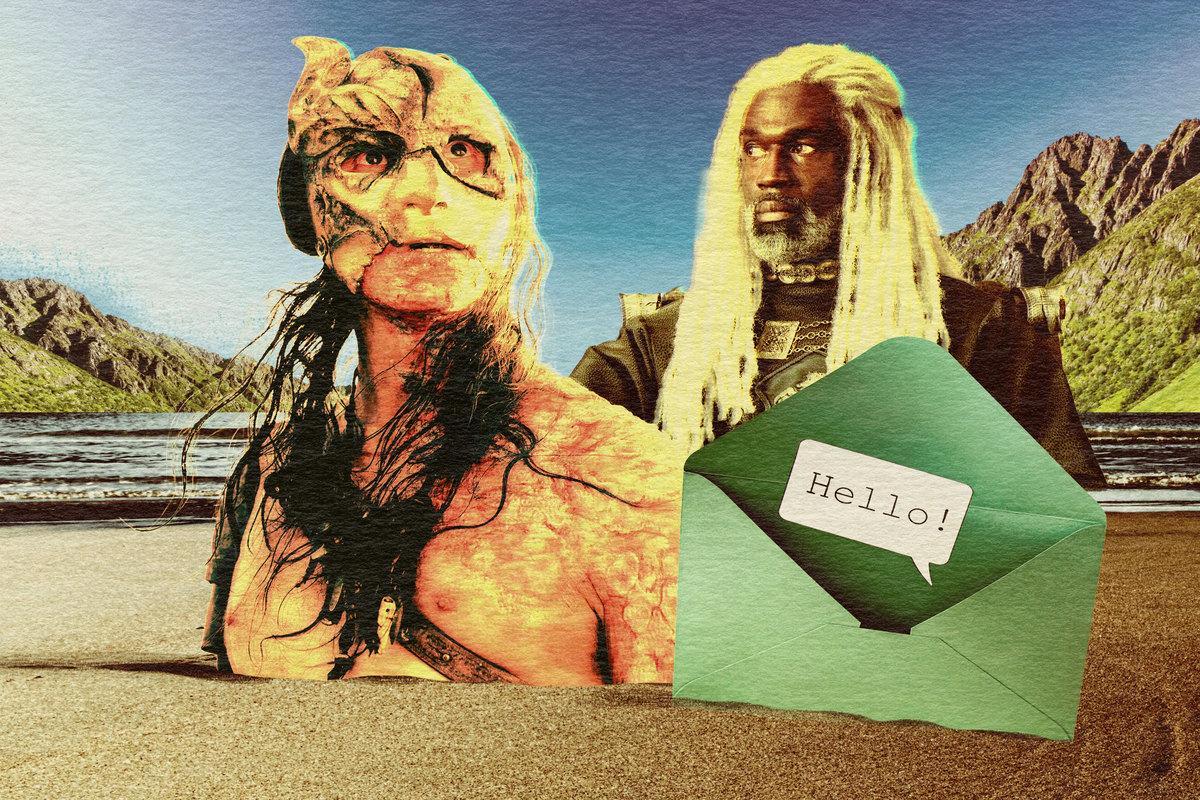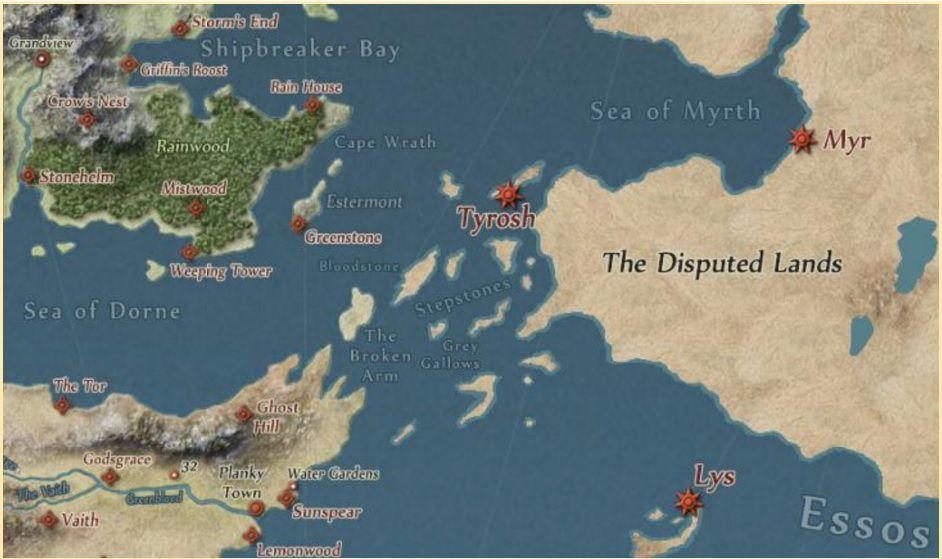‘House of the Dragon’ Episode 2 Mailbag: Crabs, Snakes, and Dragons
Spoiler-free answers about the backstories of the Crabfeeder and the Sea Snake, the whereabouts of the rest of the Targaryens, Mysaria’s accent, and more
A whole bunch of you want to know more about the Crabfeeder. And what’s the Sea Snake’s deal? And are there more Targaryens we haven’t met yet?
You sent me your questions after the second episode of House of the Dragon aired Sunday night, and here are the answers in The Ringer’s second mailbag of the season. To appear in future mailbags as Dragon continues, message me at @zachkram on Twitter or zach.kram@theringer.com each week after the episode airs.
Swati says: “I need so much more info on the Crabfeeder, very curious if that character is from the book and it almost seemed not human? Very creepy.”
The Crabfeeder is indeed in the book, and he is indeed human, and he is indeed very creepy. Craghas Drahar, a.k.a. the Crabfeeder, hails from Myr, one of the nine Free Cities, which is famous for its merchants and fine goods like lace, tapestries, and the best lenses in the known world. Myr sits on the western shore of Essos, across the Narrow Sea from the Stormlands.

Other than his home, however, we don’t know much about Craghas’s background—besides his political affiliation. Look at that map screenshot again, and you’ll see two other cities close to Myr on the Essos side of the water. Myr, Tyrosh, and Lys have been at war basically nonstop since the Doom, with constantly shifting alliances in an “Oceania had always been at war with Eastasia” sort of way. The area is so defined by strife that it’s called the Disputed Lands.
But by some miracle, in 96 AC (After Conquest), all three cities—collectively called the Three Daughters, or the Triarchy—forged a mutual alliance to defeat a fourth Free City, Volantis. That partnership was so successful they renewed it, then set their sights westward on the Stepstones, where they could wreak havoc on the shipping lanes between the two continents. The Triarchy tasked the Crabfeeder with leading that invasion. And that’s how he ended up in his position at episode’s end, killing so many sailors that he’s keeping the Stepstones’ crabs full.
George asks, “Can the Crabfeeder be defeated with Old Bay seasoning?”
As a former Marylander who put Old Bay on his eggs for lunch today, I have to answer this question. I can’t speak to the presence of the flavorful herb blend in George R.R. Martin’s world, though I imagine if it does exist, it’s probably best found in Braavos, where Arya sells her oysters, clams, and cockles.
However, I know of one weapon the Iron Throne does possess that burns hotter than any Baltimorean spice. Dragonfire has worked against Myrish pirates before, when a foolish Dornish prince named Morion Martell hired a fleet in an attempt to extend Dorne’s territory by conquering the Stormlands. But this was back in 83 AC, when King Jaehaerys was still in his prime and still had two living sons of fighting age. The three met the flotilla on dragonback and burned it all in a single day.
One of those dragons was Caraxes, ridden at the time by Prince Aemon, Viserys and Daemon’s uncle. Now, Caraxes is Daemon’s long-necked mount. If Daemon rides him into battle against another generation of Myrish ships, will the Blood Wyrm remember his feast of fire from the first encounter?
Randy asks for “more in-depth backstory on the Sea Snake.”
Let’s talk about the man bringing the fight to the Crabfeeder. Corlys Velaryon, nicknamed the Sea Snake, is the best sailor in the Seven Kingdoms and the proud leader of the Velaryon house. Fire & Blood calls him “one of the most extraordinary figures of the age” and “a man as brilliant as he was restless, as adventurous as he was ambitious.”
Almost single-handedly, Corlys built his house—which, like the Targaryens, originated in Old Valyria, but unlike the Targaryens never rode dragons—into a power in Westeros. Before Corlys, the Velaryons had always been allied with the Targaryen kings, and had always served the realm on the Small Council as master of ships. But the Sea Snake took that standing to another level.
He crossed the Narrow Sea for the first time—on his uncle’s ship—at age 6, then became a captain at 16. Thereafter, he journeyed everywhere the waters could take him: to Oldtown, Lannisport, and the Iron Islands on the western side of Westeros; to Hardhome beyond the Wall in the north; to the Free Cities of Essos and beyond in the east.
His adventures were unprecedented. At one point, he searched for Westeros’s equivalent of the Northwest Passage, looking for a route around the top of the continent, but found “only frozen seas and icebergs big as mountains.” And on the Sea Snake, the ship he designed and built, he made nine long voyages that gained him fame throughout the realm.
Destinations included Qarth and Asshai-by-the-Shadow, Yi Ti and the island of Leng, the Thousand Islands and N’Ghai and Mossovy. You probably haven’t heard of most of those places, and for good reason: Other than Qarth, where Daenerys briefly lost her dragons to strange blue-lipped warlocks, Game of Thrones never visited any of those places because they’re so far away from Westeros. Before Corlys, no Westerosi had ever visited the Thousand Islands, for instance (maybe we can get the Braavosi merchants plying Old Bay to sell Thousand Island dressing, too). But he made all those trips, and in so doing acquired immense wealth for his house through trade of foreign silks and spices.
The profits from his ninth and final adventure on the Sea Snake “were so vast that the Velaryons became the wealthiest house in the Seven Kingdoms, eclipsing even the Hightowers and Lannisters,” F&B says. So Corlys built a new family castle on the isle of Driftmark—Dragonstone’s neighbor—and married Rhaenys, cementing his relationship with the Targaryen line and fathering two children with the Queen Who Never Was.
The Sea Snake shares his wife’s frustration at the outcome of the Great Council, which named Viserys, not Rhaenys, as the Old King’s heir. And now King Viserys has spurned Corlys’s daughter, Laena, and taken Alicent for a second wife instead. This is a man who’s never satisfied and always searching for more, consumed by an urge to “press onward, to go where none had gone before and see what lay beyond the maps.” Now that his family has lost the crown not once but twice, he feels the need to act and return to a ship, where he’s most comfortable, rather than the Small Council chamber, where politics rule.
Steph Better asks, “On a scale of 1-10, how dumb is sending 20 of your best men to battle your brother & a dragon?”
To be fair to King Viserys, that was Otto Hightower’s plan, and “The Rogue Prince” displayed Otto’s strengths and weaknesses as a planner. On the plus side, his scheme to make Alicent the new queen pays off, after six months of work. The Hightowers—already a rich, prosperous family—now stand to gain even more prestige.
But on the downside, Otto’s battle tactics need some work. As I mentioned in last week’s mailbag, one key difference between Otto and Tywin Lannister—another hand whose daughter becomes queen—is that Tywin had a history as a military leader, while Otto hasn’t experienced the battlefield before. And while the confrontation on Dragonstone was not a fight per se, it demonstrated Otto’s learning curve outside the Red Keep. His bravura sure faded quickly once Caraxes made his presence felt, and Otto begrudgingly ordered his men to sheathe their steel.
In a sense, then, Otto is an inverse of not just Daemon, his fierce rival, but the Sea Snake as well. Their two houses were already rivals for wealth, with both their port homes of Oldtown and Driftmark competing to draw the highest traffic in trade from across the sea. Otto thrives in the interior confines of the Red Keep, while Corlys thrives on the open seas. And now Otto’s won the queenship for his daughter, rather than the Sea Snake for his little girl.
Yet as tensions boil and tempers flare, the misbegotten incident on the Dragonstone bridge makes us wonder: Is Otto the right man to help the king keep his command? Or is he more a peacetime adviser than a wartime consigliere?
Tom asks, “Did they make Sonoya Mizuno talk with that weirdly elaborate accent in episode one?”
The accent that Mizuno adopts when playing Mysaria, Daemon’s paramour from the Free City of Lys, isn’t how she really talks. Nor is it reminiscent of the voices of the previous Lysene characters we’ve met. It’s not how Salladhor Saan, Davos’s pirate friend, sounds, or how Doreah, one of Daenerys’s early servants, sounds, and it’s certainly not how Varys sounds. Granted, Varys could probably mask an accent given his mummer’s talents, but that list underscores that there’s no preexisting evidence of an accent like this.
Maybe Mysaria will change her voice every few episodes, as Littlefinger did on Thrones. That was a blast.
Jon asks, “Where are all the other cousins to the king?”
There aren’t many! You’ve stumbled upon an apparent paradox: Viserys’s reign represents “the apex of Targaryen power in Westeros,” according to the Fire & Blood text, yet at least at this point, there aren’t actually many Targaryens alive.
One macro issue is that the Targaryen preference for incestuous marriages naturally limits the number of little Targs running around King’s Landing. While two siblings in a normal family might go on to parent two different sets of children, two Targaryen siblings—like Baelon and Alyssa, Viserys’s father and mother—would produce only one. The Targaryen family tree is knotty because of all the incest, but it can never grow too wide.
But other issues are specific to this era of Targaryens. The problems began with Viserys’s parents’ generation. King Jaehaerys and Queen Alysanne had 13 children, but due to a variety of illnesses and fluke injuries, only five of those 13 produced any grandchildren. Then, due to even more tragedy, none of those five produced lots of children who might have further populated the Targaryen house.
We’ve already seen most of those grandchildren in the show. Baelon and Alyssa married each other and were parents to Viserys and Daemon; then Alyssa died due to the difficult birth of a third son, who died as an infant, and Baelon died without remarrying. Aemon fathered Rhaenys, but he died before siring a second child. Daella married a lord of the Eyrie and gave birth to Aemma Arryn, but died soon after a difficult labor.
The final set of Jaehaerys’s grandchildren probably won’t ever appear in the show. Saera Targaryen, Jaehaerys and Alysanne’s ninth child, was a spoiled brat as a youth and didn’t improve as she grew older. She pulled pranks around the Red Keep. (Some were funny, like dyeing the Kingsguard’s famous white cloaks pink; others less so, like filling her sister’s chamber pot with bees.) She tormented the king’s jester. She started stealing wine and alcohol from the castle kitchens by age 11.
As Saera advanced through her teenage years, that mischief manifested in sleeping around and attempting to steal a dragon, so the king and queen sent her to Oldtown to join the Faith. But Saera ran away, booked passage on a ship, and fled to Essos, where she eventually became a brothel owner in Volantis and gave birth to three kids of her own, each to a different father.
The opening narration in Dragon’s pilot episode mentions 14 total claims at the Great Council to be Jaehaerys’s heir—and three of those actually came from Saera’s bastard children, who were half-Targaryens. One was even “said to be the very image of [Jaehaerys] in his youth.” Westeros’s lords did not consider them real candidates, however, and they never appear elsewhere in the story. (Saera decided not to return to Westeros and press her own claim because she had her own life and wealth in Volantis, saying, “I have my own kingdom here.”)
And that’s the full list of Viserys’s cousins: Rhaenys, who’s still alive and at court; Aemma, who married Viserys but is now dead; and three foreigners who will never be heard from again.
That limited list helps explain the urgency around Viserys’s second marriage, because the crown needs more Targaryens in case more tragedy befalls the current ruler and heir. The crown also needs more dragonriders, because right now Rhaenyra, Rhaenys, and the estranged Daemon are the only ones, even though there are plenty more living dragons awaiting a rider.
So Viserys and Alicent will aim for children to bolster the Targaryen line. Daemon could have kids of his own, if he ever visits his wife in the Vale again. Rhaenyra will feel pressure to start having children soon, too, as the teaser for next week’s episode previews. And Laena and Laenor Velaryon, each with Targaryen blood through their mother, would be next in line for parenthood.
One final note: There are also numerous Targaryen bastards running around Dragonstone, as the dragonlords have spent centuries intermingling with commonfolk living on the island. They’ll enter this story at some point. But we don’t have to worry about them just yet.


